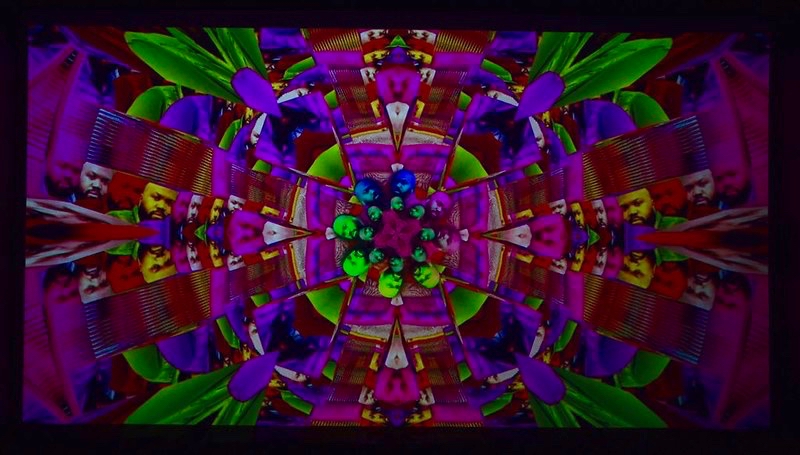
Through August 31
Multi-gallery, multi-artist events can be hard to take in, even overwhelming to the point where it can be hard to separate the wheat from the chaff. With six neighborhoods and 16 venues, the CAN Triennial, which opened in mid July and remains on view through August 31, has its stellar moments and low points, but there’s strong work to be seen at every venue.
The theme of the triennial is “You Are Here,” which is vague enough to encompass almost everything and does little to unify the disparate work. In fact, one of the weakest points is the attempt by six curators/curatorial teams to find a thread in those works, with verbiage-laden sub-themes. You could probably dig and find a connection, but it’s elusive in the larger group shows. You can safe ignore the sub-themes and just enjoy the work.
The four shows in the Waterloo Arts District show the triennial’s strengths and weaknesses. The strongest shows are the two smallest. At Brick + Mortar’s gallery, two artists — Dana Depew and Mallorie Freeman — offer mixed media work that comments on creativity, Depew on the role of the artist in a large neon installation and a wall of prints, Freeman in a series of small installations (with neon also involved) about her mother’s career as a pop singer in the 60s (you can even listen to her single which is very impressive). At William Busta Projects, Michael Loderstedt, Lori Kella, Laila Voss and Bruce Edwards, all among the area’s respected veteran artists, have worked cooperatively on a series of thought-provoking prints, photos, projections, writing and installations revolving around the topography of the lake and the region. You are here, indeed.
Both Praxis Fiber Workshop and Waterloo Arts have large group shows of unrelated pieces with vague, barely discernable “unifying” themes. While there’s some strong work, especially at Waterloo Arts, the shows are uneven with much forgettable stuff.
The Waterloo Arts show does, however, reveal something about the triennial as a whole: the artists who are already recognized are the ones who deserve most of the spotlight. At Waterloo Arts, that was people like Bellamy Printz, Douglas Max Utter, Eric Rippert, Gwendolyn Garth, Rita Montlack, Karen Beckwith and Julius Lyles. While the Triennial’s openness to new, unknown and young artists is commendable, their work just isn’t the strongest stuff in most of the venues. I didn’t see revelations; the younger artists whose work stood out, such as Ekykah Townsend and Davon Brantley, are already bathed in spotlight.
The confusing call for submissions suggested that new work would be the focus, perhaps collaborative projects such as the one at Busta. Instead, some veteran artists with established styles simply offered more of the same, excellent as it was. One collector even told me he purchased a piece because he hadn’t snagged something at a previous sold-out show, and the CAN piece he bought could’ve come straight out of that show. It seemed like the artists’ response to the theme was lackadaisical: most just did their own thing.
Despite the scattershot feel of most of the bigger group shows, the largest group show was actually the most exciting. The Galleries at CSU featured 30 artists in its sprawling space. Around every corner, there was another revelation. Once again the most powerful work was by artists that local art-lovers already knew: Kristen Cliffel’s imaginative feminist ceramic sculptures,; Micah Kraus’ relief prints, among the few works that directly addressed the Triennial’s theme, as well as a work of animation-based multiples called “Yawning Not Yelling”; Aja Joy Grant’s “Bold Fantasy” silkscreens; Aimee Lee’s ceiling-hung wall of “bricks” made from paper.
One of the most riveting pieces of the entire Triennial was at the CSU Galleries: a video by one of the best-known artists, mixed-media artist Kasumi. Her short film “Correlation” took a brief clip of curator Darius Steward, multiplied it, moved it around and then fractured it into kaleidoscopic, brightly colored psychedelic images. I watched it half a dozen times and another visitor told me they did as well. I felt like I could’ve spent the afternoon with it.
Kasumi also had two-dimensional digital collages at Waterloo Arts which points to a difficulty in absorbing the Triennial’s shows. The same artists had work at different locations. It was suggested that this gave visitors the chance to see the artist at another location if they missed them at one, but it didn’t give you a well-rounded feel for their practice. Kasumi’s work at Waterloo Arts without knowing her video-based work wasn’t as interesting. It would’ve benefited from being alongside her film and two large metallic “Lenticular” prints at CSU.
The show at the Sculpture Center/Artists Archives of the Western Reserve showethe strength of grouping artists’ work. Here were five of Hadley Connor’s haunting photo-based mixed-media images that exuded “You are here.” Here were four complex, maze-like images by Will Wilson with their pointed yet not heavy-handed social commentary. Here were veteran artist David Buttram’s gritty yet romantic urban scenes. You could immerse yourself in the artists’ visions.
Still, there was interesting work at every venue. Another group show, at the Hildebrandt Building, has an intriguingly diverse group of works: a gorgeous head-in-hand sculpture by Kristen Newell, a bright, busy, engaging mixed-media piece called “(What This Area Needs is…) a new pool” by Laureen Deveny, one of Jon Kvassay’s mysteriously sinuous creature paintings (more are on view at the Pivot Center), one of Amy Casey’s distinctively haunting paintings of an urban building awash in nature (more of her work is on view at ArtNEO), and a huge textile wall hanging with pompoms by Katlin Shae, well described by its title “Undulating Waves with Technicolor Glitch.” This show is hard to find but well worth seeking out.
The Triennial’s official closing date in August 31; with some of the venues open only limited weekend hours, this weekend may be your last time to see the shows. For days an hours, go to cantriennial.org.